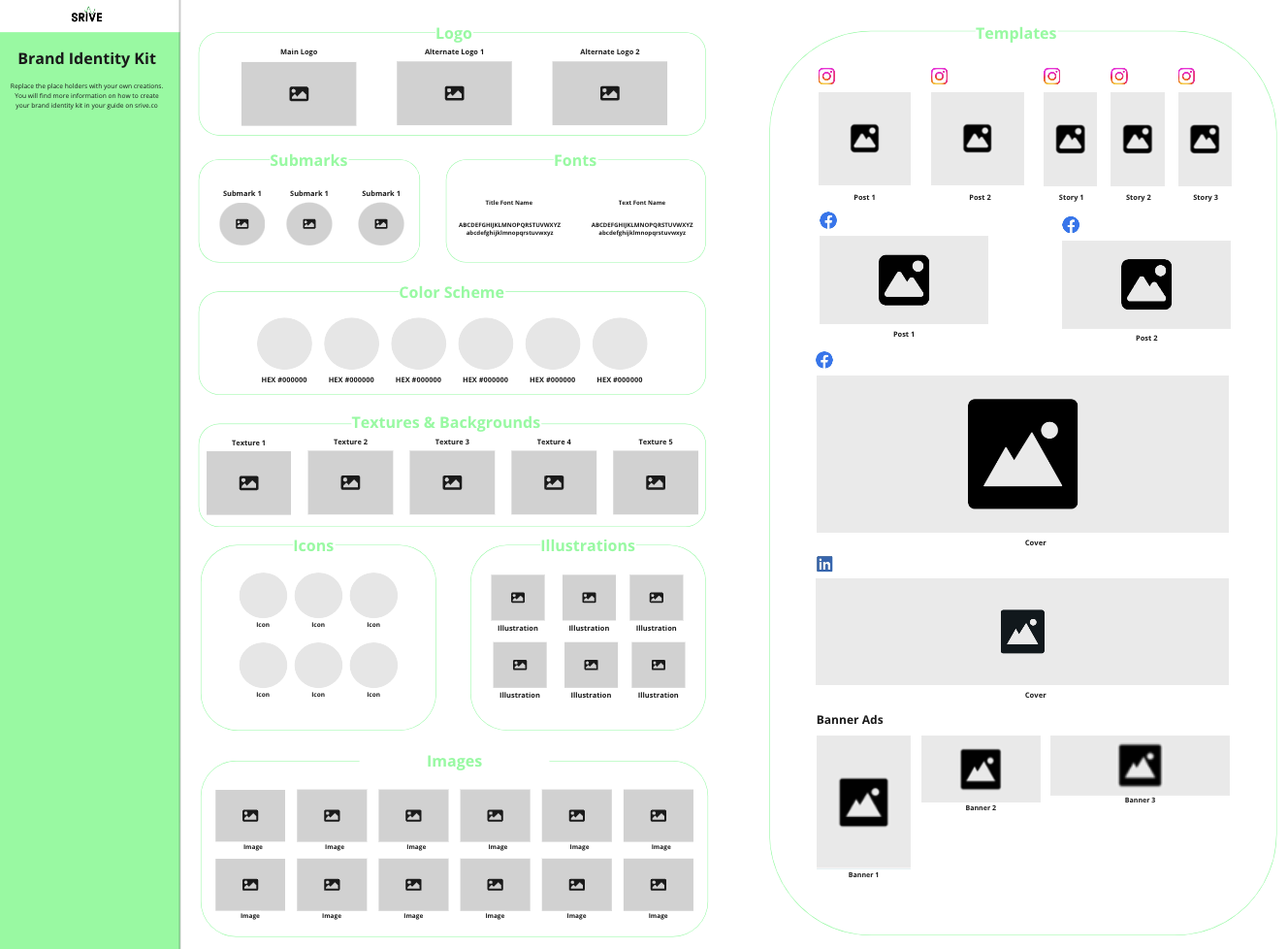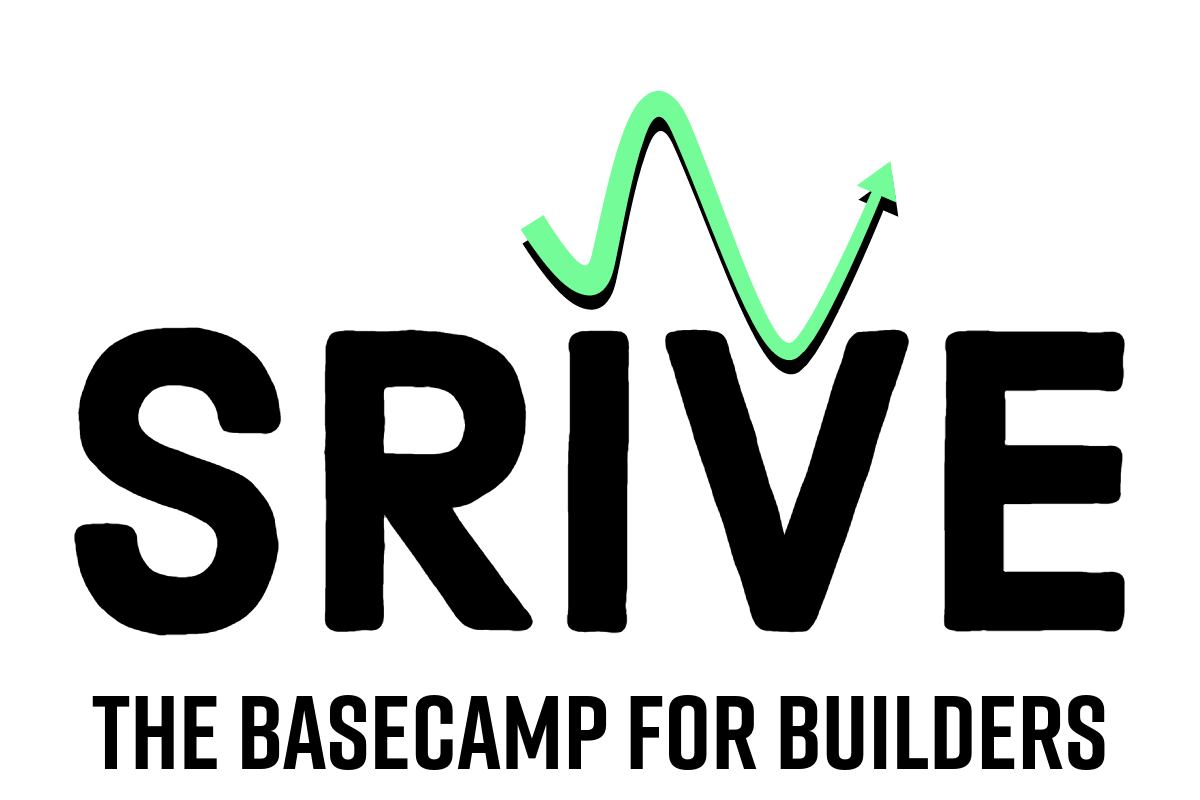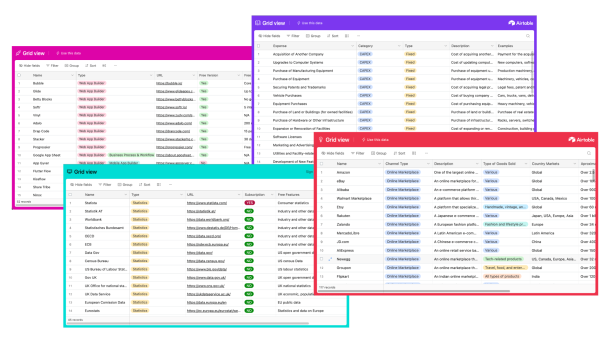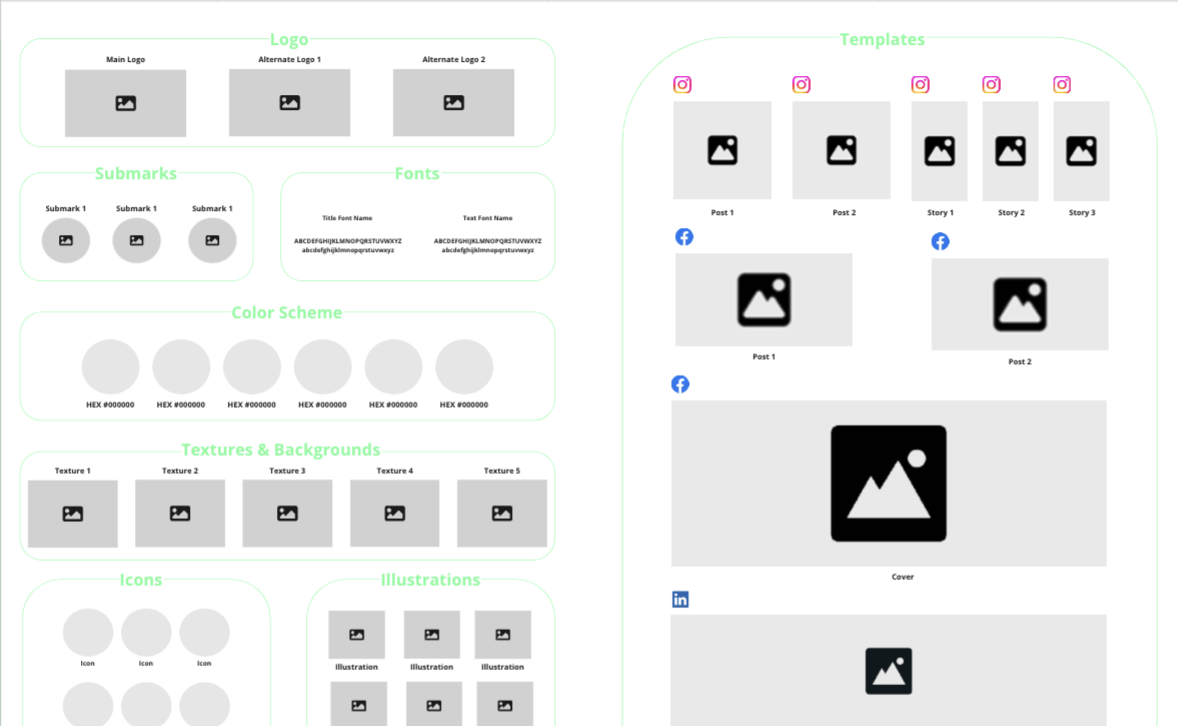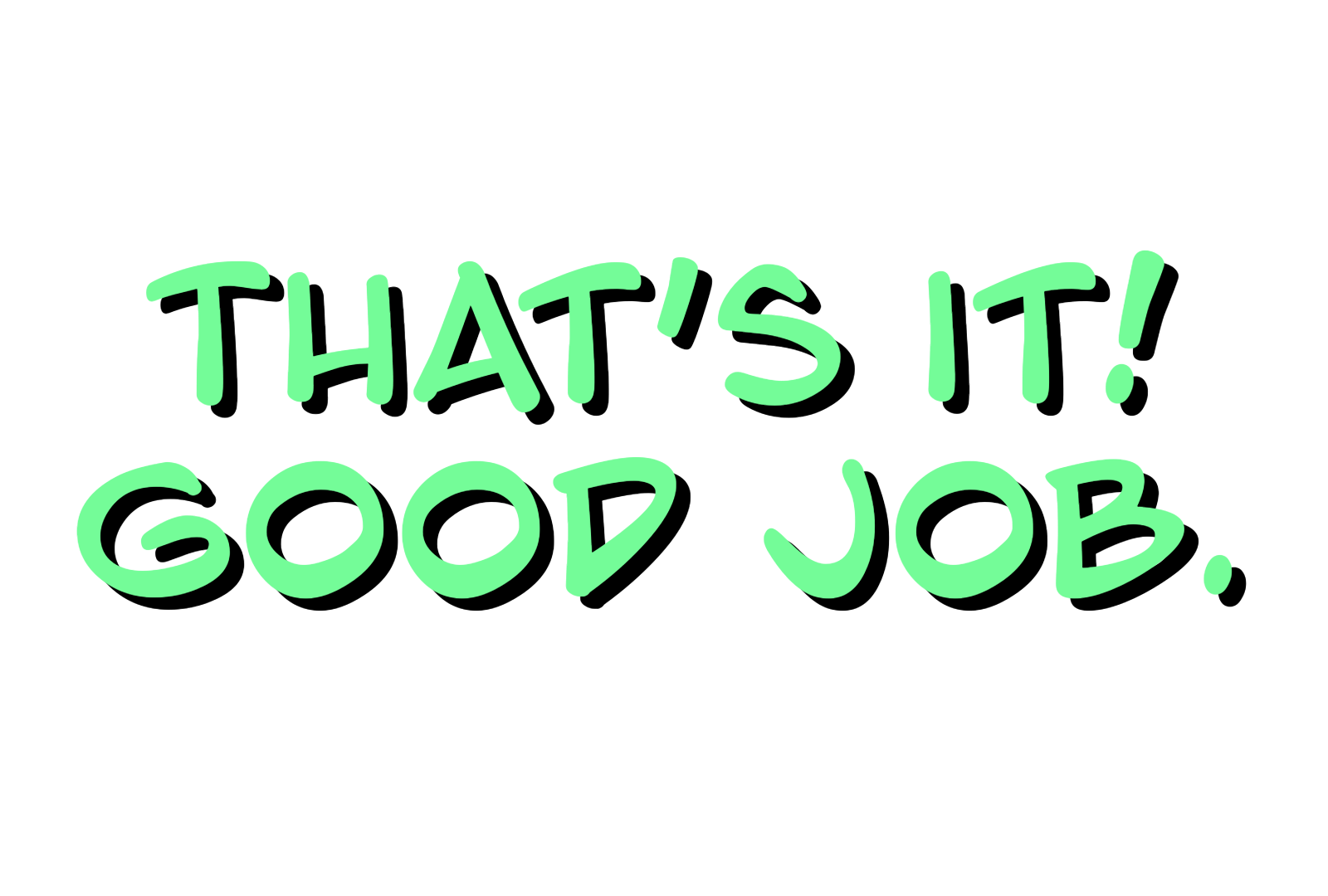Branding Strategy & Design Guide
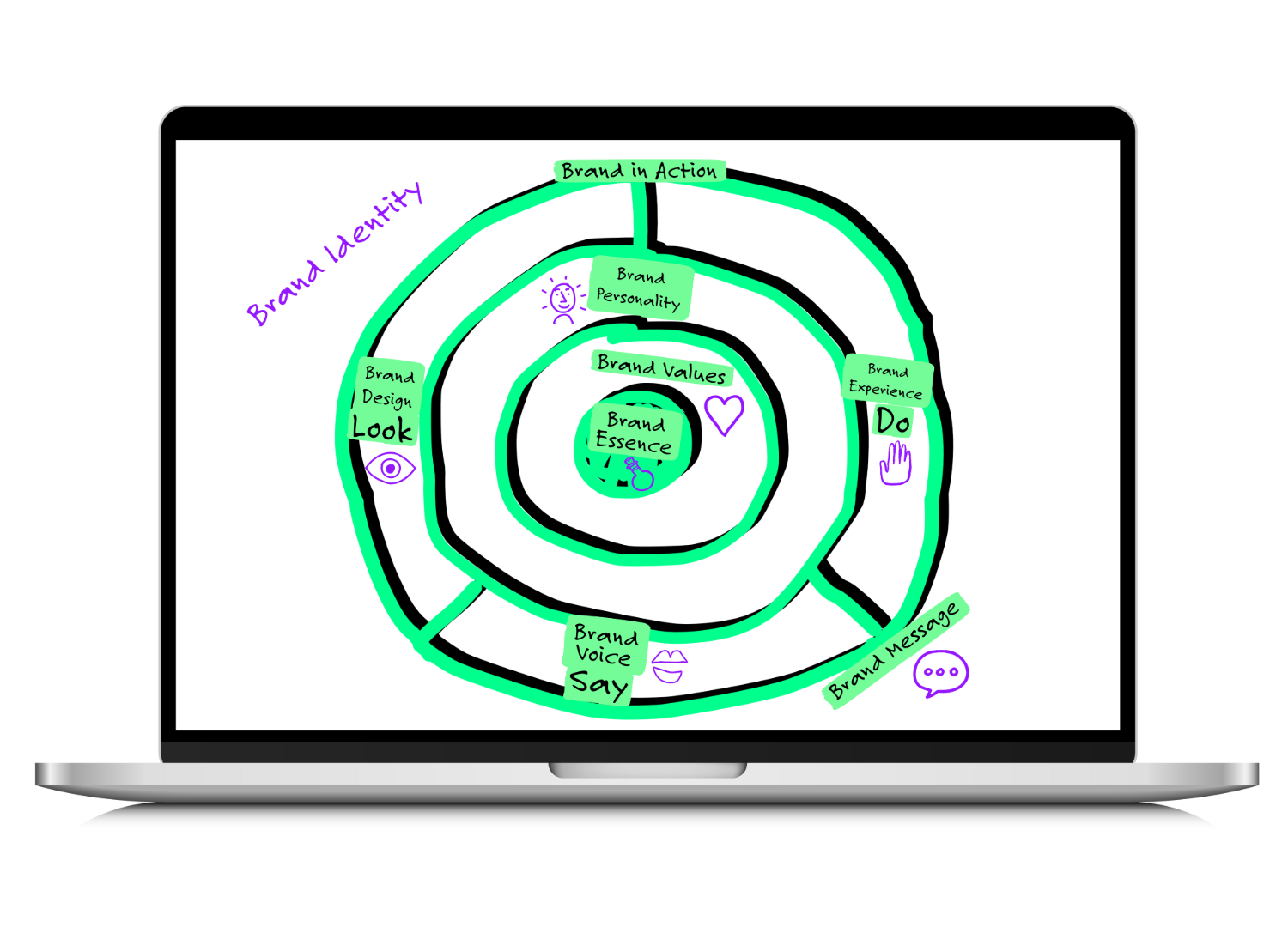
What is Branding Strategy & Design?
Your branding is much more than a name and a logo. It is how you are or aiming to be perceived by your target audience. It is the unique identity and image you create and maintain for your product, service, or organization through the design, the way you communicate, the messages you send and the experience you provide.
Your Branding differentiates your products or services from others in the market. It is a way to make a product or service stand out and be memorable, and it helps to create loyalty and long-term customer relationships. It is used to create a perception of quality and trust in the minds of customers, and to communicate the benefits and values of the brand.
To be more specific, we will focus today and tomorrow on creating your brand identity. The brand identity is the visual, verbal and actionable elements that make up your brand. It is the way the brand presents itself to the world.
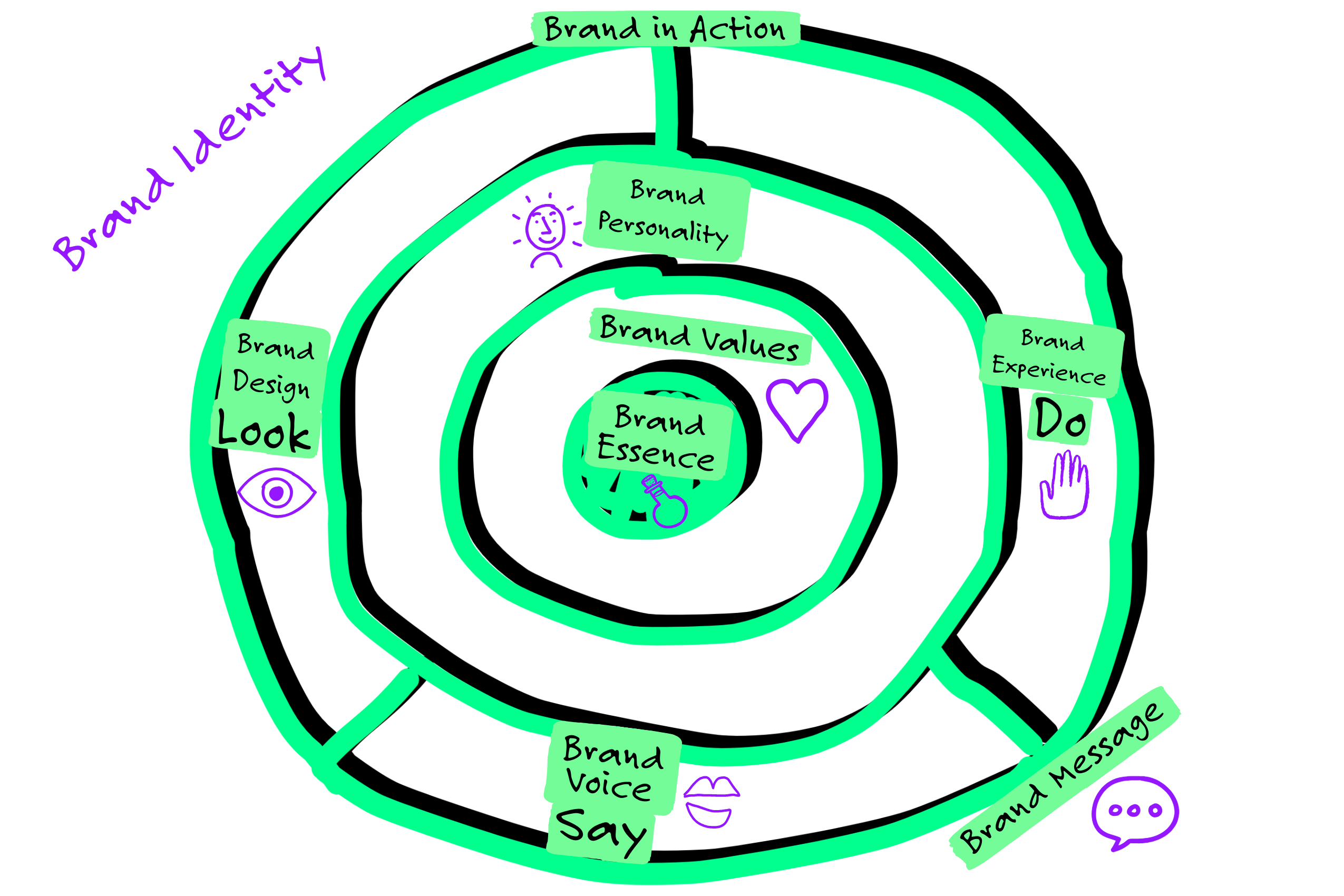
We can use the so-called “Brand Onion” framework to define your brand identity. The onion consists of 4 main layers and 6 elements, which we will work through today and tomorrow.
Brand Essence: The innermost layer that represents the company’s purpose. It represents the company’s reason for existence, what it stands for and what it wants to achieve.
Brand Values: The layer that represents the company’s beliefs and principles, and communicates what the company stands for and what it values most.
Brand Personality: It is the set of human characteristics that are attributed to a brand. It is the unique personality that the brand projects to the world, and it represents the company’s personality and behavior, and communicates how the company behaves and how it is perceived by others.
Brand in Action: The outermost layer that represents the company’s interactions with customers and is divided into three parts:
- Brand Design: What the brand looks like. Meaning the visual elements of a brand, such as the logo, color scheme, typography, imagery, and packaging that helps to create a memorable and recognizable brand, differentiate it from competitors and communicate the brand’s value proposition.
- Brand Voice: What the brand says, including the tone, language, and messaging used to communicate with customers.
- Brand Experience: What the brand does, including how customers experience the brand through various touchpoints, such as the website, packaging, customer service, advertising, and the product or service itself. It encompasses the entire customer journey.
While you can always work through this guide on your own and within the time you need, we recommend doing so using a one-day workshop format with the whole team. If you don’t have enough participants, you can always invite some of your peers to participate. If they fit into your target user profile, even better. If you’re a solopreneur and can’t get anyone to join in, you can of course also go through the different tasks by yourself.
You can hold this workshop in person or remotely, collaborating on the digital whiteboard.
Just as for your design sprint workshop, it is also advisable to have a facilitator and a decider.
The facilitator is responsible for leading the team through the workshop, helping the team stay focused, managing the schedule, and ensuring that everyone has an equal opportunity to contribute their ideas.
The decider is responsible for making final decisions about which ideas and concepts to move forward with.
Note: 🍋 Throughout this guide, we will use the example of a food supplement company to better illustrate each task and information.
What is a Branding Strategy & Design Good For?
For any business, a well-defined branding strategy is crucial. It not only helps your product or service stand out, but also fosters customer loyalty and long-term relationships. A well-defined branding strategy and design will help you to create:
- Memorability: A distinct brand stands out and remains in the minds of customers.
- Differentiation: Sets your product or service apart from competitors.
- Customer Loyalty: Builds trust and encourages repeat business.
- Perceived Quality: Creates a perception of quality and trust.
- Effective Communication: Clearly communicates the brand’s values and benefits.
- Long-term Success: Lays the foundation for lasting success and growth.
Curated Lists 📋
💡 To save you some time, we have prepared a free list with Branding Tools which will be helpful when creating your brand strategy and design.
How to Define Your Branding Strategy & Design Step-by-Step:
Step A: Branding Strategy Template
Step B: Brand Essence & Values
Step C: Brand Personality
Step D: Brand Design
Step E: Brand Name & Tagline
Step F: Brand Identity Kit
Step A
Brand Strategy Templates
To work on your brand strategy and brand identity kit you can either build your own whiteboard templates for example on Miro or you can use our ready-to-use templates along with this guide.
Included Templates:

Branding Strategy Miro Board

Brand Identity Kit Miro Board
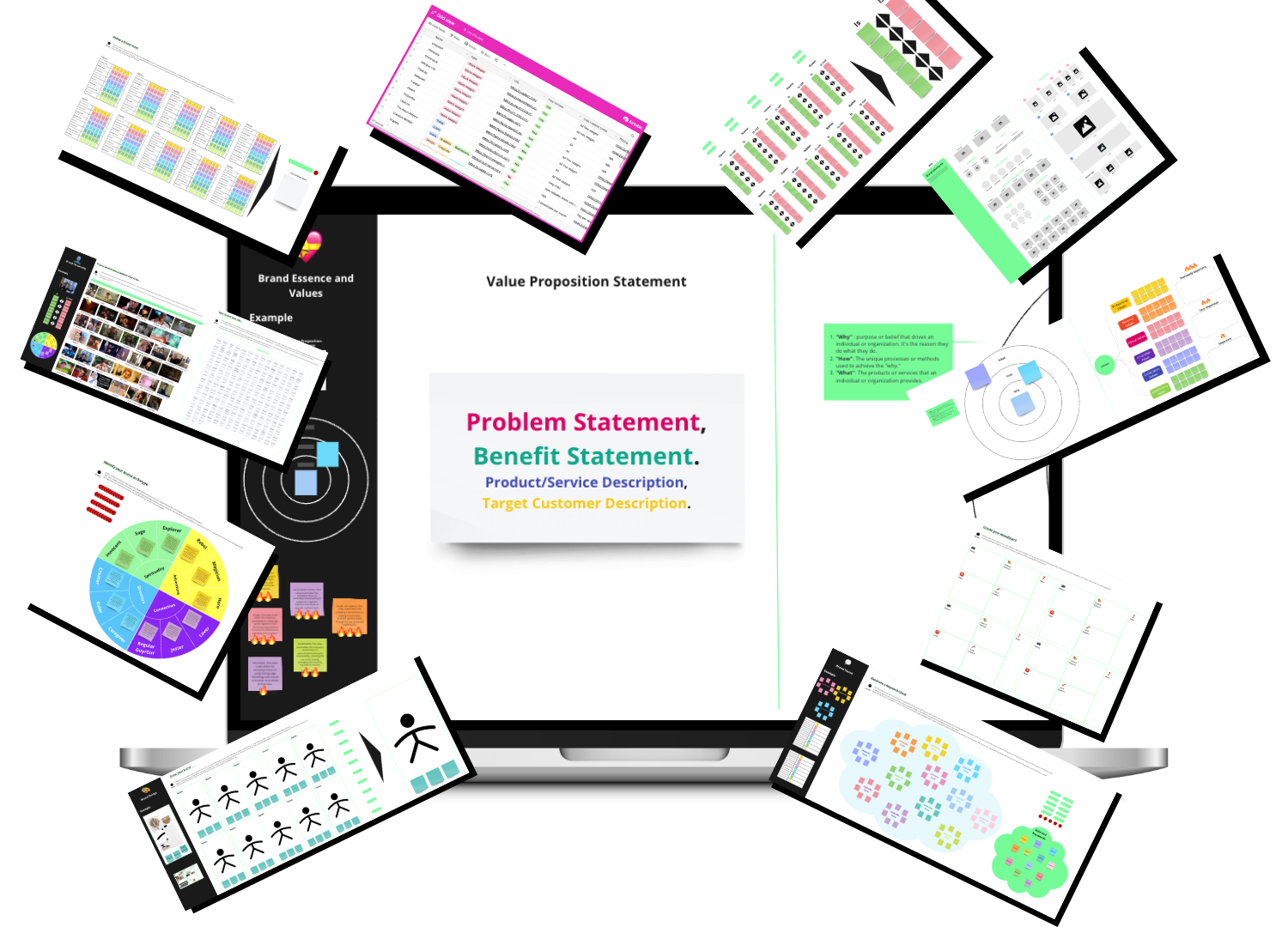
Step B
Brand Essence & Values

In the very first step, we will work on your brand essence and value. Your value proposition, purpose and values is something you probably have defined already at this stage, if so just copy them to your Brand Strategy 📒Template, go through them with the team and have them present.
If not use the “quick & dirty” version in your guide or check out the Value Proposition Design toolkit and Vision Alignment Toolkit for the detailed step-by-step approach.
So to start use the first area of your Brand Strategy 📒Template and follow the steps below.

✅ Define your Value Proposition Statement
To define your value proposition statement you can use a four parts approach. Your message should contain 4 types of information:
-
Problem Statement: What is the problem you are solving with your product/service?
-
Benefit: What benefit does your product/service offer that solves this problem?
-
Product/service category: What is it that you are offering? Which term does describe your product/service?
-
Target Customers: To whom are you offering this product/service?
Brainstorm and define a value proposition statement. You can for example imagine you want to define the header message for your website or landing page, what would you say to explain your value proposition in 2 lines and catch the attention of your visitors.
✅ Define your Purpose
Next, let’s define your businesses purpose. A great tool to do this is the “Golden Circle” developed by Simon Sinek. The Golden Circle consists of three elements: why, how, and what.
-
The “why” refers to the purpose or belief that drives an individual or organization. It’s the reason they do what they do.
-
The “how” refers to the unique processes or methods used to achieve the “why.”
-
The “what” refers to the products or services that an individual or organization provides.
☝️ Think about how you/the team would answer the following questions and collect your answers on the Brand Strategy 📒Template.
Why: What is the reason your business exists? What is your company’s purpose, and what are your core beliefs? What does your company bring to the world?
How: How do you put the “why” into action? What are you doing differently from competitors, what makes you special? What values and principles guide your actions?
What: What is it that you actually do? What is the outcome of the “why”? What products and/or services do you offer?
✅ Define your Value
And finally, you want to define your brand’s values. Values are the guiding principles that shape your company’s culture and influence the way it conducts business. They form the foundation of your company’s beliefs and reflect its fundamental approach to the world.
There are different types of values, such as:
-
Professional values: These values relate to the way your company conducts itself in its business and professional relationships, such as integrity, professionalism, and excellence.
-
Personal values: These values relate to the way your company treats its employees and stakeholders, such as respect, fairness, and inclusivity.
-
Ethical values: These values relate to the way your company behaves in an ethical and socially responsible manner, such as honesty, transparency, and responsibility.
-
Innovation values: These values relate to the way your company approaches problem-solving and innovation, such as creativity, adaptability, and continuous learning.
-
Collaboration values: These values relate to the way your company works with others, both internally and externally, such as teamwork, cooperation, and collaboration.
-
Sustainability values: These values relate to the way your company approaches environmental and social sustainability, such as conservation, social responsibility, and sustainability.
Think about or brainstorm with your team to determine which values apply to your business. What is important to you and your team, and therefore your company? What does it stand for and represent? Which principles guide the way your company works and does business?
The values can be described in single words or full sentences, and you do not have to find values in each of the above categories, but they can serve as a guide.
☝️ Note them down on your Brand Strategy 📒Template and classify the values by their level of importance.
-
The extremely important values are the ones you want to base your mission and culture on and that define your business internally and externally.
-
The very important values should be followed in day-to-day operations and be incorporated into your rules of conduct.
-
The important values should be respected whenever possible.
Step C
Brand Personality

Let’s continue with identifying your brand personality.
As explained earlier, the brand personality refers to the set of human characteristics that are attributed to a brand. It is the way a brand speaks, behaves, and is perceived by consumers. It is the way a brand expresses its unique identity and differentiates itself from other brands. Brand personality is not a physical thing, it is the way a brand is perceived in the minds of consumers.
A well-defined brand personality helps to build a strong and consistent brand identity, and to create an emotional connection with consumers. Consumers are more likely to form a relationship with a brand that they perceive as having a personality similar to their own. A well-defined brand personality can also help in building brand loyalty and in differentiating a brand from its competitors.
We will now work on three exercises to define your brand’s personality.
✅ If your brand was a famous character… (20min)
Look at the famous characters on the Brand Strategy 📒Template and think about how they are like and what they might reflect. Now imagine your brand was a famous character, who would your brand be?
Every team member takes a voting dot below and chooses a character. Now discuss your choices quickly, everyone explains why he chose his character. Finally, agree on one character that best represents your brand.
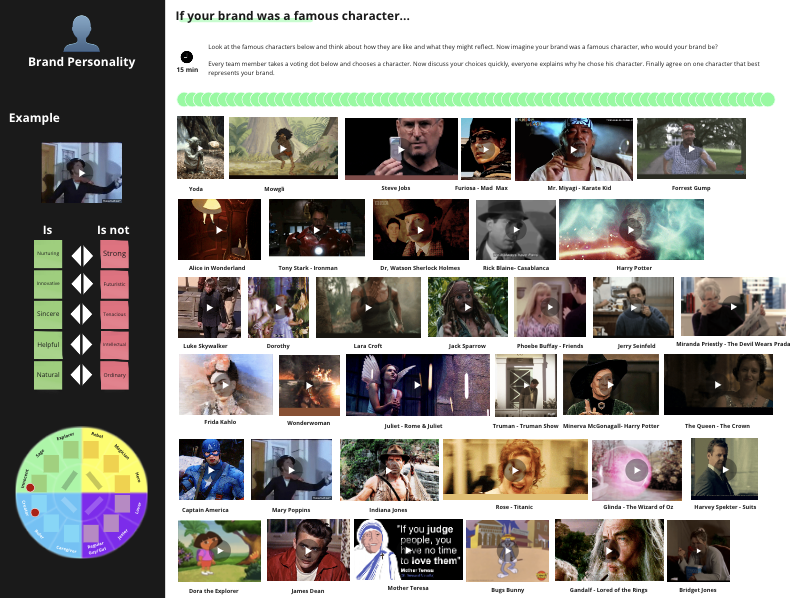
✅ Your brand is/is not… (20min)
Now imagine again your brand was a person, which adjectives would describe your brand best and which don’t. Every team member can pick from the adjectives on the Brand Strategy 📒Template, or find his/her own adjectives, find 5 adjectives that reflect their brand’s personality and for every adjective find an opposing pair. For example, you could say: “Our brand is down-to-earth but not ordinary”.
Once every team member finishes writing down the adjectives, everyone gets 5 green voting dots, looks at all the adjective pairs and picks the 5 pairs he finds to describe the brand best.
Finally, discuss the pairs in the group and select the final 5 pairs. The decider gets the final vote.
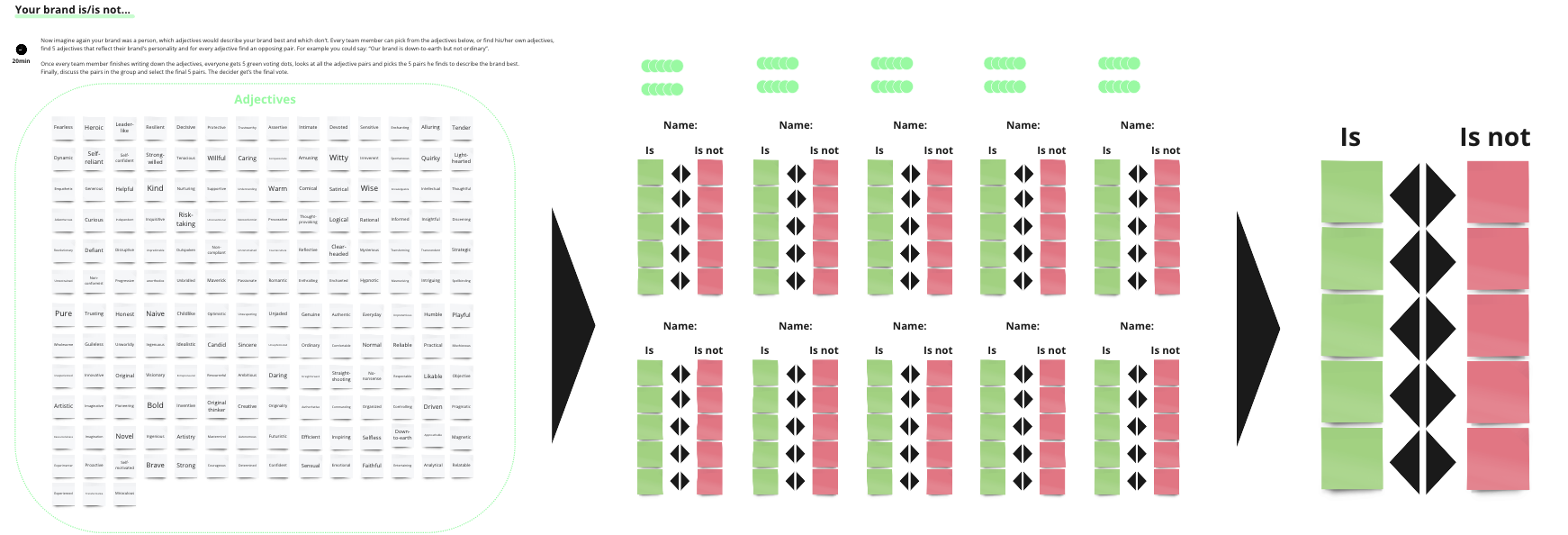
✅ Identify your archetype… (20min)
Finally, using your character and adjectives, we will determine your brand archetype.
Brand archetypes are a set of universal, symbolic characters that represent the different aspects of human nature and can be used to create a strong and relatable brand identity. The concept of brand archetypes was first introduced by Carl Jung, a Swiss psychiatrist, who identified twelve universal archetypes that represent the different aspects of human nature.
You can align your brand with one or multiple archetypes to create a relatable and compelling brand identity. By aligning with a specific archetype, your brand can tap into the universal emotions and values associated with that archetype, and create a deeper connection with its target audience.
The twelve brand archetypes are:
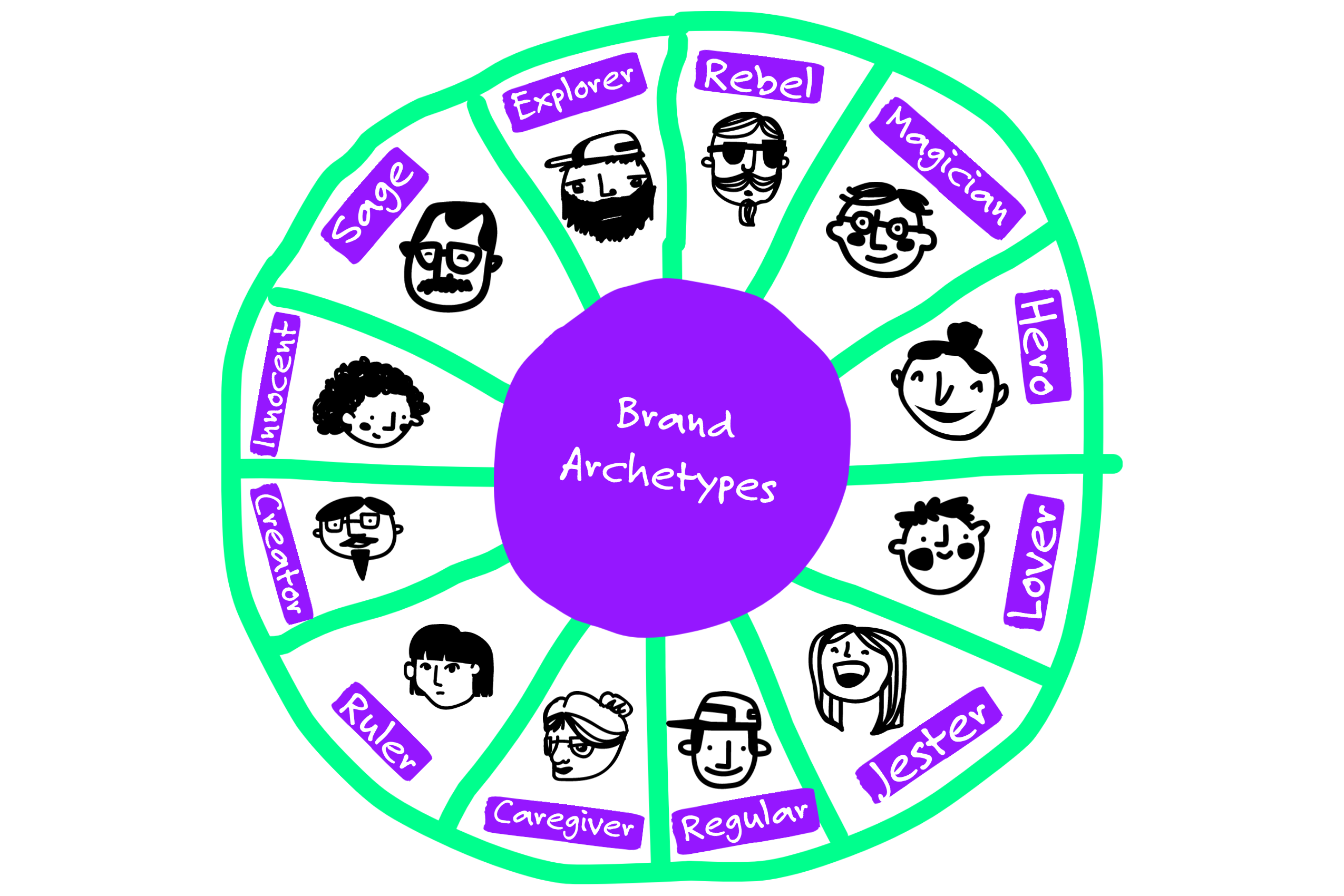
- The Innocent: represents purity, ideals, and the pursuit of happiness. This archetype is associated with brands that promote simplicity, naturalness, and a sense of community. ➡️ Characters: Dorothy from The Wizard of Oz, Alice from Alice in Wonderland, Mowgli from The Jungle Book
- The Creator: represents originality, innovation, and artistic expression. This archetype is associated with brands that are unique, independent, and that break away from conventions and traditions. ➡️ Characters: Tony Stark/Iron Man from the Marvel Cinematic Universe, Steve Jobs, Frida Kahlo
- The Hero: represents courage, leadership, and the pursuit of excellence. This archetype is associated with brands that inspire confidence and empower their customers to achieve their goals. ➡️ Characters: Luke Skywalker from Star Wars, Superwoman, Captain America
- The Caregiver: represents compassion, generosity, and a sense of responsibility. This archetype is associated with brands that prioritize the well-being of others and work to make a positive impact on the world. ➡️ Characters: Mother Teresa, Dr. John Watson from Sherlock Holmes, Mary Poppins
- The Explorer: represents adventure, freedom, and the pursuit of knowledge. This archetype is associated with brands that encourage customers to take risks, step out of their comfort zones, and experience new things. ➡️ Characters: Indiana Jones from the Indiana Jones, Lara Croft, Dora the Explorer
- The Rebel: represents nonconformity, individuality, and the rejection of the status quo. This archetype is associated with brands that challenge the status quo and inspire customers to think for themselves. ➡️ Characters: James Dean, Jack Sparrow, Furiosa Mad Max
- The Lover: represents romance, passion, and the pursuit of connection. This archetype is associated with brands that evoke feelings of love and connection and that help customers to create meaningful relationships. ➡️ Characters: Casablanca’s Rick Blaine, Juliet – Romeo and Juliet, Rose from Titanic
- The Jester: represents humor, playfulness, and the celebration of life. This archetype is associated with brands that bring joy and laughter to people’s lives. ➡️ Characters: Jim Carrey’s character in The Truman Show, Bugs Bunny, Phoebe Buffay from Friends
- The Sage: represents wisdom, knowledge, and the pursuit of understanding. This archetype is associated with brands that provide a sense of guidance and enlightenment. ➡️ Characters: Yoda from Star Wars Mr. Miyagi from The Karate Kid, Minerva McGonagall from Harry Potter
- The Magician: represents transformation, vision, and the power of imagination. This archetype is associated with brands that help customers to achieve their goals and realize their full potential. ➡️ Characters: Gandalf from The Lord of the Rings, Harry Potter, Glinda the Wizard of Oz
- The Regular Guy/Girl: represents relatability, down-to-earthness, and the everyman. This archetype is associated with brands that are accessible, honest, and easy to relate to. ➡️ Characters: Jerry Seinfeld from Seinfeld, Forrest Gump, Bridget Jones
- The Ruler: represents authority, power, and the pursuit of success. This archetype is associated with brands that inspire confidence and empower customers to take charge of their lives. ➡️ Characters: The Queen from The Crown, Miranda Priestly – The Devil Wears Prada, Harvey Specter – Suits
Review the 12 archetypes and read their descriptions. Now use the corresponding area of your Brand Strategy 📒Template to vote. Each team member chooses the archetype(s) that they believe fit best, and marks it using a voting dot. Then, discuss the chosen archetypes as a group and come to a consensus on one or more archetypes that best represent your brand’s personality. The decider will have the final vote once again.
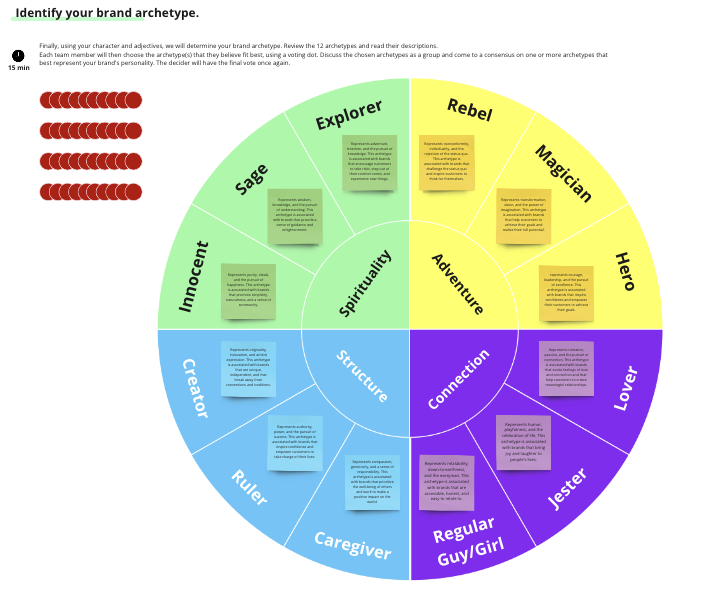
Step D
Brand Design

Next up, we will focus on defining your brand design.
The brand design is the visual expression of your brand’s identity. It involves creating a visual system that accurately reflects the brand’s values, personality, and messaging, and encompasses elements such as logos, color palettes, typography, imagery, and overall visual style. A consistent and recognizable look and feel can help your brand stand out in a competitive marketplace and establish a connection with your target audience.
We will again begin with a fun exercise, so go to your Branding Strategy 📒Template and get started.
✅ Dress your brand… (30min)
Imagine that your brand is a person, and you are its personal stylist. How would you dress it? What shoes, bottoms, and tops would it wear? Would it prefer a dress, onesie, jacket, handbag, or jewelry?
Research clothing and accessories online and create a complete look. Attach pictures to your figure and describe the look in three words. After each participant finishes their look, present it to the group. Then, vote for the best look or elements of the look. Finally, select the brand’s final look as a group, with the decider having the final say.
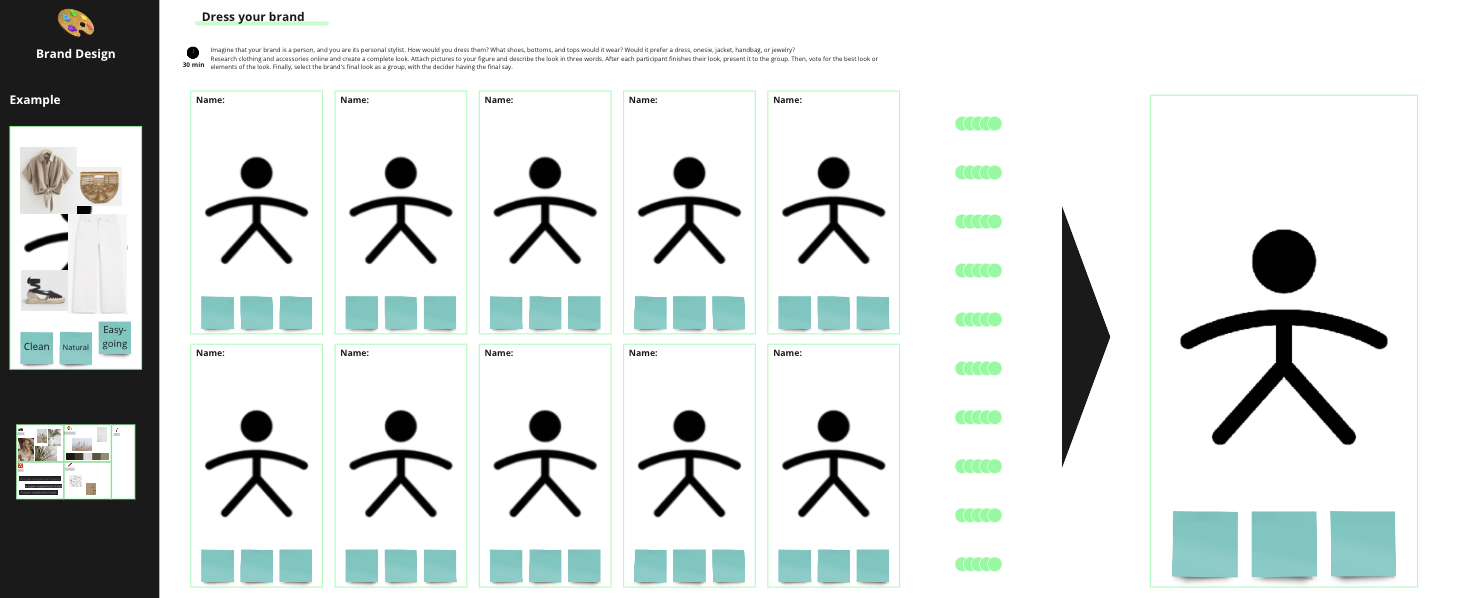
✅ Create your moodboard… (30min)
Based on the chosen style, you are now going to create your moodboards.
A mood board is a visual representation of the desired style, tone, and feel of your brand design. It is typically made up of a collage of images, colors, textures, and typography that provide inspiration and set the overall direction for the design. They help to communicate ideas and align on the desired aesthetic, and can be used to guide the development of the design concept and final product.
Google for inspiration like photos, color schemes, and textures, fonts, art, and graphics, and others. Collect them on the moodboards on your whiteboard template. You can use these as a reference when creating your brand assets.
Also, there are a number of tools that you can use to create your moodboard. For example, check platforms like unsplash or pixabay for image inspiration, Google Fonts or Adobe Fonts, to find fonds you like and Colorhunt or Colorkit to find the right color scheme. You find a number of great tools on your Branding Stack 📋List.
Now each team member can choose a square in the Branding Strategy 📒Template to create their mood board.

Step E
Brand Name & Tagline

Lastly, you will work on finding the right name and tagline for your brand. Your brand name should serve as a representation of your brand and the values, qualities, and attributes it represents and help to build brand recognition and awareness in the minds of your customers.
Your tagline, on the other hand, is a short, catchy phrase that summarizes the core message or identity of your brand. Your tagline is intended to create an emotional connection with the target audience. A good tagline should be memorable, easily recognizable, and closely aligned with the brand’s values and mission. Examples of famous taglines include Nike’s “Just Do It,” Coca-Cola’s “Open Happiness,” and McDonald’s “I’m Lovin’ It.”
Again, you will work with the team step by step to find your ideal brand name and tagline. Remember, you will find a dedicated area for each task on your whiteboard 📒Template to collaborate.
✅ Generate a Keyword Cloud… (20min)
Firstly, you want to start with identifying your brand’s keywords.
Take 5 minutes to discuss in the group which important umbrella terms define your brand. Keep in mind your value proposition, the benefits you offer, your mission and vision statement, and your values and brainstorm in the group, then note your terms down in the keyword cloud. In the next 5 minutes, every participant thinks about keywords related to the different umbrella terms individually and notes them down. Finally, during the last 10 minutes, it’s time to vote, discuss and decide. Every participant gets 5 green voting dots to select the keywords they consider most important, then discuss your choices with the group and make the final selection. The decider has the last word as usual.
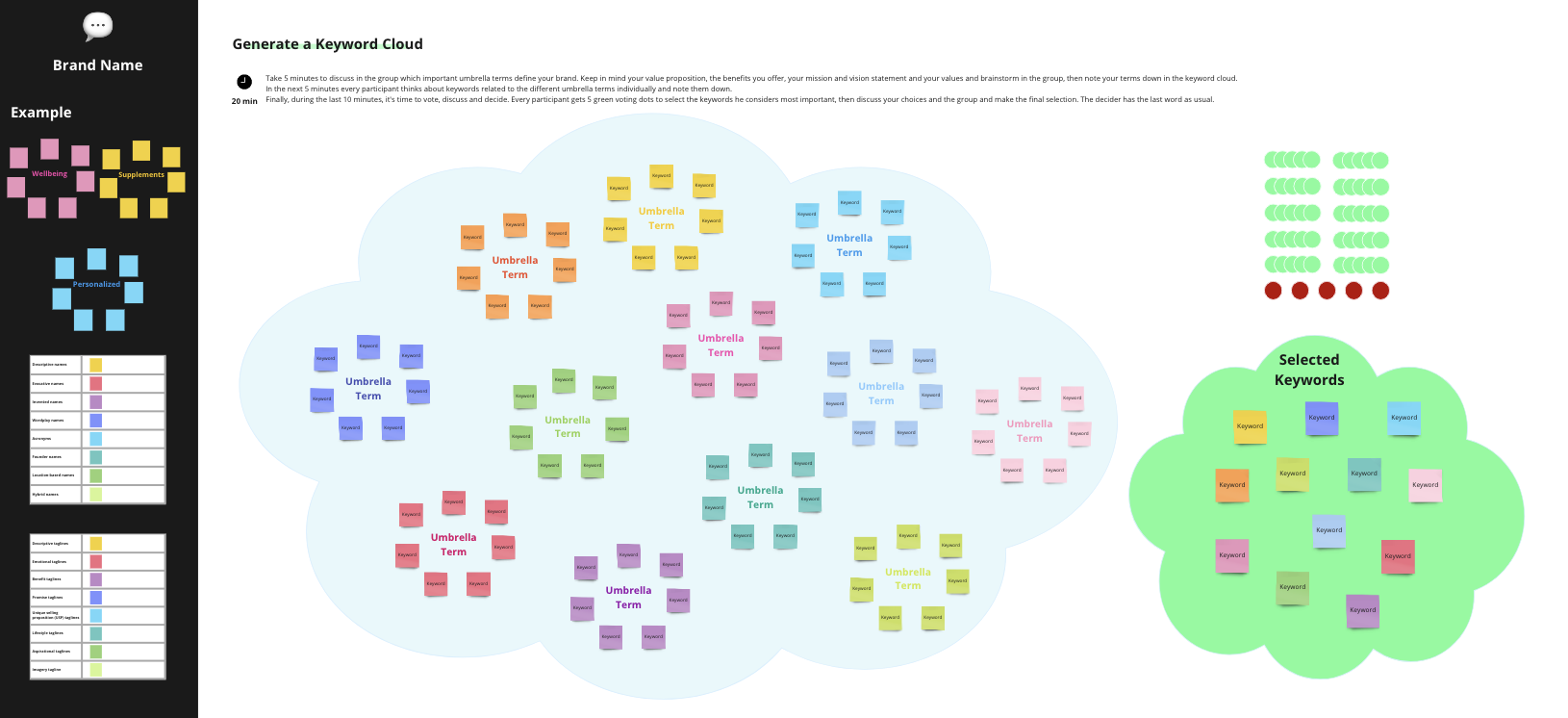
✅ Define your Brand Name (40min)
Now let’s work on your brand name. The first 20 minutes, everyone works on their own, generating various brand name ideas based on the different types explained below and with the selected keywords in mind. Then, again vote, discuss and select. This time, everyone gets only one dot to vote for their favorite brand name during 5 minutes. In the remaining 15 minutes, discuss the choices in the group, and finally, select a brand name. The decider has the final vote.
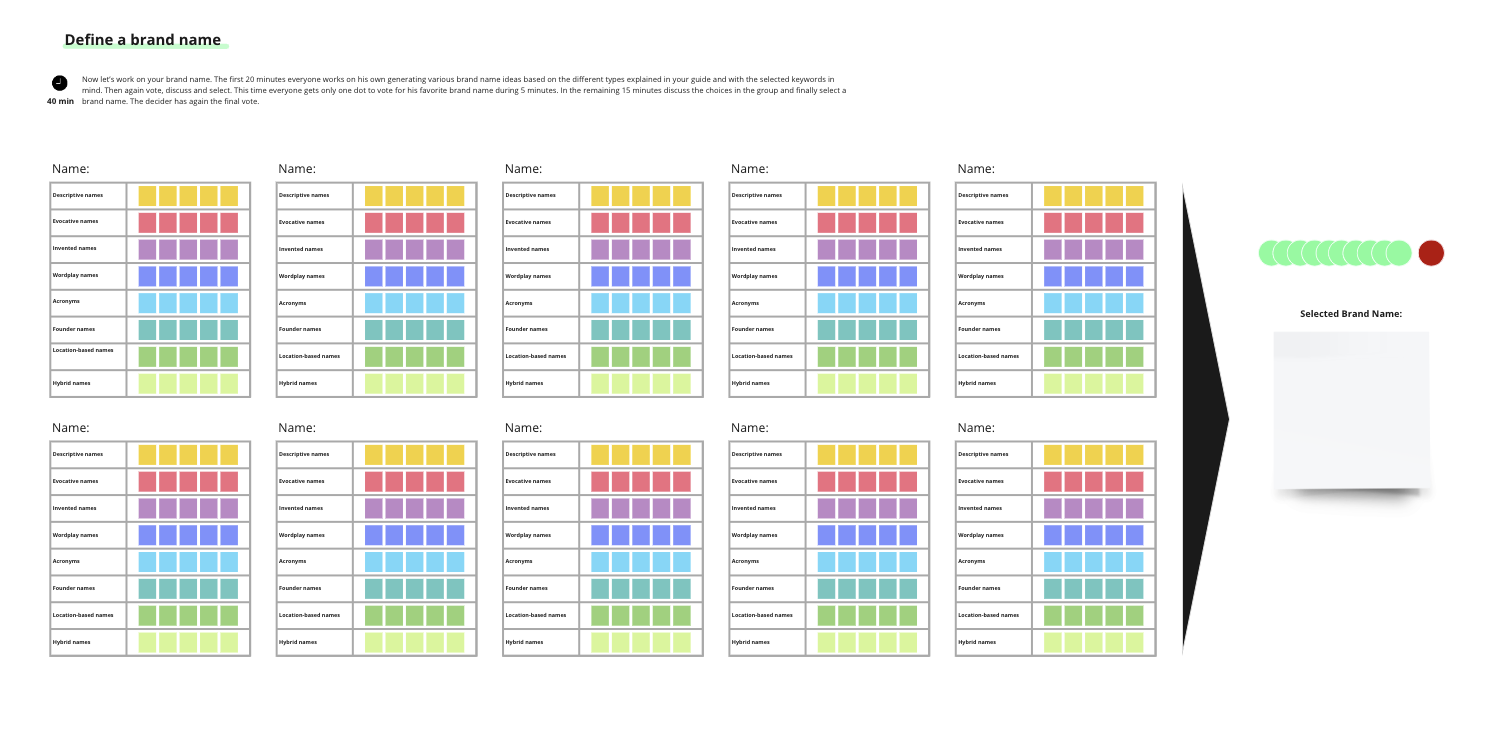
The different types of brand names are:
- Descriptive names: A descriptive name clearly describes what the company does. 👉For example: Claritin (describes a clear head), Tide (describes the cleaning properties of the product)
- Evocative names: An evocative name evokes a feeling or emotion. 👉For example: Nike (evokes victory), Apple (evokes simplicity, health, and a positive image)
- Invented names: An invented name is a made-up word that has no meaning. 👉For example: Kodak (made up), Sony (made up)
- Wordplay names: A wordplay name uses puns, word associations or intentional misspellings. 👉For example: 7-Eleven (plays off of the store’s extended hours), FedEx ( combination of “Federal” and “Express”)
- Acronyms: An acronym uses the first letters of multiple words. 👉For example: BMW (Bayerische Motoren Werke AG), GE (General Electric)
- Founder names: A founder name uses the name of the founder, 👉For example: Ford (after Henry Ford), McDonald’s (after the founders, the McDonald brothers)
- Location-based names: A location-based name uses the location of the company. 👉For example: American Airlines (originated in America) Kentucky Fried Chicken (originated in Kentucky)
- Hybrid names: A hybrid name combines elements from different types of names. 👉For example: Adobe (combination of the founder’s name and a word), Microsoft (combination of microcomputer and software)
✅ Define your Tagline (30min)
Finally, let’s get to defining your tagline. Here we will follow the same process as for your brand name. The first 15 minutes everyone works individually generating ideas for the different types of taglines that are again explained below. Then again, take 5 minutes to vote using the dots (1 dot per person). And finally, take 10 minutes to discuss your choices and make a final selection.
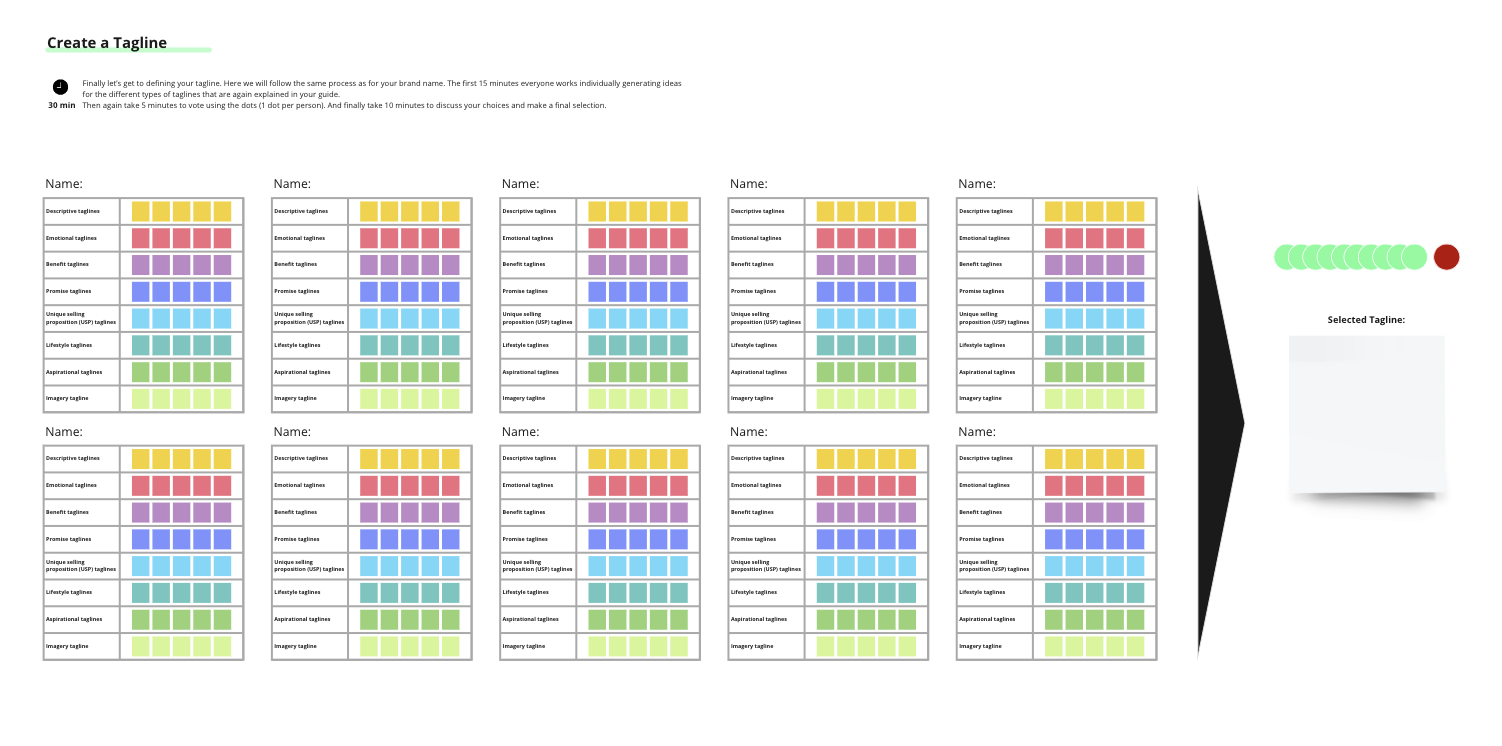
The different types of taglines are:
- Descriptive taglines: These taglines describe the product or service in simple, straightforward terms. 👉For example: “The Quicker Picker Upper” – Bounty paper towels
- Emotional taglines: These taglines tap into the emotions of the target audience and evoke feelings such as happiness, excitement, or trust. 👉For example: “Because You’re Worth It” – L’Oreal Paris
- Benefit taglines: These taglines focus on the benefits that customers will receive from using the product or service. 👉For example: “Helping you get there.” – FedEx
- Promise taglines: These taglines make a promise to customers about the quality of the product or service. 👉For example: “Melts in Your Mouth, Not in Your Hands” – M&Ms
- Unique selling proposition (USP) taglines: These taglines highlight what sets the product or service apart from the competition. 👉For example: “The Ultimate Driving Machine” – BMW
- Lifestyle taglines: These taglines associate the product or service with a particular lifestyle or way of life. 👉For example: “Because You’re Not Just Anybody” – Tommy Hilfiger
- Aspirational taglines: These taglines inspire customers to aim for a better future or higher goal. 👉For example: “Just Do It” – Nike
- Imagery tagline: These taglines use vivid imagery to create a visual representation of the product or service. 👉For example: “The Happiest Place on Earth” – Disneyland
Awesome! With this task you finish your workshop. So go and recharge your energy for tomorrow.
Step F
Brand Identity Kit

This last step is also going to be a fun one, since today you will create your brand identity kit.
The brand identity kit is a collection of visual and written elements that define your brand. The purpose of a brand identity kit is to ensure consistency in the presentation of a brand across all touchpoints, including marketing materials, website, and social media.
Your brand kit typically comprises at least:
- Logo versions: Different variations of the main logo, including horizontal and vertical versions, one-color versions, and inverted versions.
- Submarks: Smaller versions of the main logo, typically used as secondary logos or in situations where the full logo isn’t feasible.
- Color palette: A collection of brand colors and their codes, used consistently across all materials to create a cohesive look and feel.
- Typography: The choice of fonts used for brand text, including headers, body copy, and other elements.
Plus, you can add other visual elements that across your different brand touchpoints like your website, advertisements, social media channels and so on. This can be, for example:
- Iconography and symbols: Unique symbols or icons that represent the brand, often used in marketing materials or on product packaging.
- Graphic patterns and textures: Recurring visual elements, such as patterns and textures, used to add interest and dimension to brand materials.
- Imagery and photography: The visual elements used to tell your brand’s story, including product photography, stock photography, and custom illustrations.
- Product packaging design: The design of the physical packaging of the brand’s products, including colors, graphics, and typography.
- Templates: Pre-designed templates, social media graphics, website design templates, business card and stationery design or presentation templates used to ensure consistency across all brand communications.
So today will be all about developing your brand identity kit. There are of course a variety of options to create your brand kit, which one you choose mainly depends on your budget.
- Hire an agency: You can of course hire an agency to design your branding, this is probably the most expensive option but also likely the highest quality option at the same time.
- Hire a freelancer: You can also work with individual freelance designers to develop your branding, they usually charge a little less agencies. You can find freelancers on platforms like Upwork, Fiverr or 99 designs, check out the branding stack 📋List for more.
- Use design on-demand subscription platform: You can also use a design on-demand platform, where you pay a monthly subscription free and can order design projects whenever you need them examples are Superside or Penji, you will find more on the branding stack 📋List.
- Use premade brand kits and adapt them: Then there is the option to find ready to use brand identity kits that you like and maybe adapt them. You can even find them on Etsy or platforms like creative market.
- Use AI tools: Then there is of course the option of using AI and other tools that automatically generate Logo option for your brand like Looka or Logo.com
- Do it yourself: And finally, there is of course the option to do it yourself. Maybe you are even a professional already and know how to work Adobe Illustrator and Photoshop. If not, I’ll give you some options “for Dummies” of how you can create graphic elements and build up your brand kit.
Remember, you can use our template to put together your brand identity kit.
When developing your brand design, you want to keep in mind all the outcomes from yesterday’s workshop. Keep in mind your brand personality and use the mood boards that the team created as references.
Define your color scheme
To start, you want to define your color scheme. Choosing the right colors for your brand design is important because colors have the ability to evoke emotions, create moods, and influence people’s perceptions of the brand. Different colors have different cultural and psychological associations, and the colors you choose will affect how people perceive your brand, communicate your brand values and personality, and increase brand recognition.
A well-chosen color palette can enhance brand recognition, convey brand personality and increase brand recall. Additionally, a consistent use of color across all your brand assets will strengthen brand recognition, convey brand personality, and help you create a memorable brand image.
Let’s make a quick excursion into color theory:
First of all different colors have different meanings, which you should consider:
- Red: energy, passion, excitement, love, strength, power
- Orange: warmth, friendliness, creativity, optimism, enthusiasm
- Yellow: happiness, optimism, playfulness, caution, intellect
- Green: growth, nature, health, stability, peace, envy
- Blue: trust, stability, calmness, professionalism, security, sadness
- Purple: luxury, sophistication, creativity, mystery, spirituality
- Pink: femininity, romance, playfulness, innocence, nurturing
- Brown: stability, reliability, earthiness, warmth, simplicity
- Black: sophistication, power, formality, mystery, mourning
- White: purity, innocence, peace, cleanliness, simplicity
- Gray: balance, neutrality, stability, calmness, professionalism
Second, when selecting different colors for your brand’s palette, you should keep in mind the following rules for your palette to look harmonious.
- Complementary colors: This method involves selecting two colors that are opposite to each other on the color wheel, such as blue and orange, green and red, or yellow and purple. These colors tend to contrast well and create a balanced, eye-catching composition.
- Triadic colors: This method involves selecting three colors that are evenly spaced around the color wheel. This creates a harmonious color palette that is well-balanced and visually appealing.
- Analogous colors: This method involves selecting colors that are next to each other on the color wheel, such as blue and green, or red, orange and yellow. These colors create a harmonious palette with a consistent color scheme.
- Monochromatic colors: This method involves selecting colors that are variations of a single color, such as light blue, medium blue and dark blue. This creates a harmonious palette with a consistent color scheme.
- Split-complementary colors: This method involves selecting a base color and then two colors that are adjacent to its complementary color. This creates a harmonious color palette with a mix of contrast and balance.
There are a number of tools like Adobe Colors or Color Hunt that help you to create a color scheme for your brand. You can find a range of tools on your branding stack 📋List.
Choose a font
The right font helps your brand to communicate the it’s personality and tone of voice. Moreover, it helps to create a visual hierarchy and improve legibility, making the brand more memorable and easily recognizable.
A font can also influence the way that a brand is perceived, for example, a more traditional font may convey a sense of stability and professionalism, while a more modern font may convey a sense of innovation and creativity. The choice of your font also should align of course with the brand’s values and goals, and be consistent across all brand materials.
- Serif: these fonts have small lines or flourishes at the end of each stroke. ➡️They are often seen as traditional, sophisticated, and elegant. They are best used for formal or classic branding.
- Sans-serif: these fonts have no serifs. ➡️They are seen as more modern, clean, and simple. They are often used for branding that wants to convey a more minimal, contemporary look.
- Display: Display fonts are designed specifically for use in larger sizes, such as headings or titles. ➡️ They are often more decorative and eye-catching and can convey playfulness or expressiveness.
- Script: Script fonts are designed to look like handwriting and often have fluid, connected letterforms. ➡️ They can convey a personal, friendly, or romantic feel and are best used in branding that wants to evoke a sense of handcrafted quality.
- Monospace: these fonts have equal spacing between each character. ➡️They are often seen as technical, computer-based, or utilitarian. They can convey a sense of stability and structure and are best used in branding that wants to convey a sense of reliability and efficiency.
You can discover, try and download a huge range of fonts from Google Fonts or Adobe Fonts. Use either of those tools to search and try the right fonts for your brand.
Create your logo
The most important element of your brand design is probably your logo. The logo is a visual representation or symbol that serves as an identifying mark for your company, brand, product, or service. It is an element that encapsulates your values, personality, and mission of the brand in a simple and memorable form, and helps to differentiate your brand from its competitors.
To create your logo you can use an AI logo maker tool or, if you want to design something more individual, graphic design tools like Adobe Express or Canva. Besides being easy to use, they offer a wide range of templates that make it very easy to create appealing logos. Most of those tools offer a free version with limited functions. You will find a range of tools on your branding stack 📋List.
Find images, backgrounds & textures
You probably also want to select images or backgrounds and textures that reflect your brand, its personality and values. You can use those images for your website or templates, and they can serve as a style reference for the future when selecting further photos. There are a variety of platforms that offer free or paid stock photos like Unsplash, Pexels or Pixabay. You will find even more on your branding stack 📋List.
When choosing images, keep in mind the following factors:
- Relevance: The images should be relevant to the brand and its products or services.
- Brand values and personality: The images should reflect the brand values and personality.
- Consistency: The images should be consistent with the overall brand design and color palette.
- Quality: The images should be high-quality, clear and free of distractions.
- Emotional appeal: The images should evoke the desired emotions in the target audience.
- Uniqueness: The images should be unique and not easily replicated by others.
- Context: The images you choose should also fit into the context, such as website backgrounds, product packaging, and marketing materials.
Design graphics & templates
Finally, you could also create graphics or templates for ad banners, social posts, social stories, cover images and so on. For this, you can again use drag and drop graphic design tools like Adobe Express or Canva. They also come with a wide range of templates that you can use as a basis to start designing.
With that said, go ahead, have some fun and get creative. Don’t forget you can use your Brand Identity 📒Template to collect all your assets and designs.
